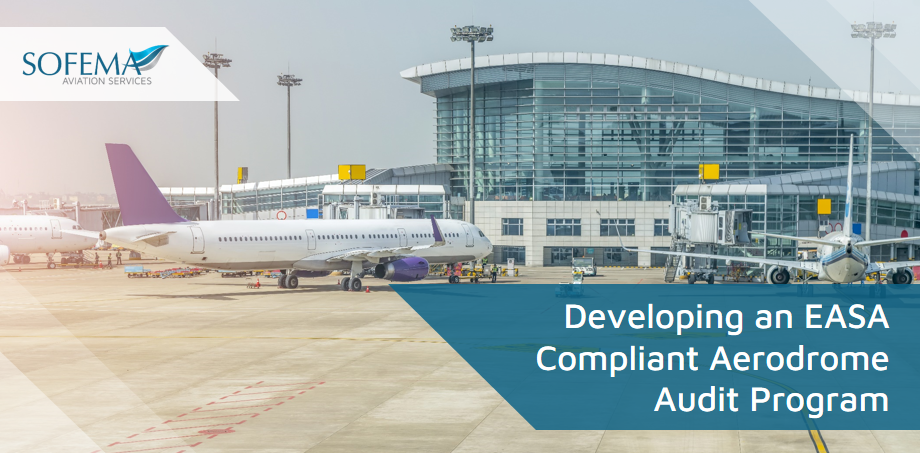Sofema Aviation Services (SAS) www.sasofia.com considers the criteria which should be assessed during an aerodrome audit to ensure a regulatory-compliant aerodrome operation.
Introduction
Introduction to the Performance of Mandatory Regulatory Audits at EASA Certified Aerodromes.
An aerodrome operator is tasked with the responsibility of monitoring compliance ensuring that activities are carried out safely.
- This encompasses a broad spectrum of operations, from the privileges of the aerodrome operator to the management system procedures and manuals.
- The organizational setup, compliance monitoring, and audit scheduling are integral components of this monitoring process.
- An aerodrome operator should monitor compliance with the procedures it has designed, to ensure safe activities. In doing so, the aerodrome operator should as a minimum, and where appropriate, monitor compliance with:
– Privileges of the aerodrome operator
– Manuals, logs, and records
– Training standards
– Required resources
– Management system procedures and manuals
– Organisational set-up
Compliance Monitoring — Audit Scheduling
A defined audit schedule should be completed during a specified calendar period and a periodic review cycle for each area should be established.
- Both the Safety System as well as the Compliance Monitoring Program itself should also be audited according to a defined audit schedule.
- The schedule should allow for unscheduled audits when trends are identified.
- Follow-up audits should be scheduled to verify that corrective action was carried out and that it was effective and completed, following the policies and procedures specified in the aerodrome manual.
The aerodrome, its management system key processes, procedures and its operation should be audited within the first 12 months since the date of the issuance of the certificate.
After that, the aerodrome operator should consider the results of its safety (risk) assessments and its past compliance monitoring activities.
This calendar period should be consistent with the relevant competent authority’s oversight planning cycle and may be increased, up to 36 months, in coordination with the competent authority, provided that there are no level 1 findings, and subject to the aerodrome operator having a good record of rectifying findings on time.
- In order to adapt the calendar period within which an audit or a series of audits should be conducted, to cover:
– The whole aerodrome,
– Its management system key processes,
– Procedures and its operation in a manner, and at intervals set out in the aerodrome manual.
Example Auditing Program: Compliance Audit Schedule Development for EASA Aerodrome Operations
To ensure that EASA standards are met and maintained, a structured audit program is essential.
- The process document provided outlines a systematic approach to developing a compliance audit schedule.
- It begins with setting clear objectives, which define the purpose, scope, and frequency of the audits.
- Establishing criteria is the next step, where regulatory requirements, best practices, and previous audit findings are taken into account.
The audit schedule should be developed, detailing the areas of operation, objectives, frequency, and other pertinent details.
- This schedule is dynamic and is reviewed and updated regularly to ensure its continued relevance. Communication is the final, yet crucial step, ensuring that all stakeholders are informed and aligned.
Example Audit Criteria (Consider as a Generic Sample Only)
- Management of Change
- Use of Alcohol
- Contracted Activities
- Coordination with other Organisations
- Personnel Requirements
- Prevention of Fire
- Record Keeping
- Training and Proficiency
- Aerodrome Monitoring and Inspection
- Aerodrome Maintenance
- Low Visibility Operations
- Wildlife Management
- Obstacles and Flight Procedures
- Occurrence Reporting
- Operation of Vehicles
- Airfield Ground Lighting
- Rescue and Fire Fighting Services
- Safety Directives
- Safety Programmes and Committees
- Safety Reporting System
- Winter and Adverse Weather
- Apron Management
- Aerodrome Manual
- Aerodrome Safeguarding
- Demonstration of Compliance
- Findings And Corrective Actions
- Fuel Management
- Water Management
- Lavatory Waste Management
- Emergency Planning
- Aerodrome Data Quality Requirements
- Aerodrome Work Safety
Compliance Audit Schedule Development for EASA Airport Compliance
Developing Audit Criteria
Determine the primary goals of the audit. (Review EASA regulations and standards relevant to airport operations.)
- This could be to ensure safety,
- Regulatory compliance,
- Compliance with the Aerodrome Process & Procedures
- Research industry best practices to identify additional audit criteria.
- Review findings from previous audits to identify areas of concern or non-compliance.
Consider the Area of Audit
- Define the areas of operations that will be audited:
– Reference any of the aforementioned areas.
Identify the Frequency of Audit (This could be annually, bi-annually, quarterly, etc.)
Note that “little & often” provides for a more successful level of engagement.
Capacity Planning:
- Identify the number of auditors required, their qualifications, and training needs.
- Determine the tools, software, and other resources needed to conduct the audit.
- Estimate the time required for each audit, considering the scope and complexity.
Next Steps
Please see the following course EASA Airports Aviation Compliance Management and Auditing – 4 Days or email team@sassofia.com for additional information.
Tags:
EASA, aviation services, SAS blogs, SAS training, compliance monitoring programme, Aviation Training Standards, Aerodrome Audit, EASA Aerodrome Operations





